The Many Paths to Noise Reduction: An examination of some ingenious devices that make our sonic universe quieter.
by Robert Long
------------
LET'S CONCEDE ONE SALIENT FACT right from the start: In the best of all possible audio worlds, noise reduction would be neither necessary nor desirable. Noise-reduction circuitry adds to the complexity and cost of our equipment; it also adds measurable (though seldom audible) distortion. In the never-never land of ideal audio, there would be no significant noise to reduce. Recording-studio air-conditioners would not rumble, nor would turntables. Tape hiss would be a supersonic whisper; all FM stations would be strong enough and all tuners good enough to deliver, say, at least 70 dB of dynamic range. Mass-produced records would retain the mirrored perfection of the lacquers from which their masters are processed; pops and clicks would be as self-healing as mosquito bites. The word "hum" would retire to its original meaning: a happy offhand vocalize.
Our real world is-and for the predictable future will continue to be-quite different. Some of the reasons are technological: Signal-to-noise ratios in some areas simply are as good as we know how to make them. Others are economic. We can reduce tape hiss, for example, by using higher transport speeds or wider tracks, but that raises both tape costs and, to some extent, the cost of the transports needed to handle the bulkier tapes. And the digital audio-processing systems that, in theory, would prevent all accretion of noise and distortion in signals stored and manipulated in digital form are extremely expensive.
So we live with more noise than we would like and seek ways to reduce it. When we find those means we often discover, concurrently, some of the fascinating byways of the human psychoacoustic mechanism-perceptual quirks that alter the way we "hear" noise reduction by contrast to the way we might expect to hear it: as the simple removal of noise content. One's subjective perceptions, that is, may be quite different from the objective "fact" of mere noise reduction. Some of the subjective phenomena that we will be discussing are easily explained in terms of commonly accepted psychoacoustic law (or, perhaps, lore); others are not so easily explained. So it must be understood as you read this article that the subjective value judgments it contains are mine and that your psychoacoustic mechanisms may not always be have identically.
Two particular effects--"psychoacoustic syndromes" might be an appropriate term-stand out among those that we will have cause to refer to repeatedly when we come to discuss the several noise-reduction systems. For want of better (or at least, widely recognized) terms, let's call them the Change Factor and the Expectation Factor.
The Change Factor
It is axiomatic that the ear is far more sensitive to change than it is to precise continuous values. At 10% fast, for example, a deck will make music sound almost a whole tone sharp (theoretically un detectable unless you have perfect pitch), slightly bright (which could be misconstrued as a function of the equalization in the recording), and ever so slightly rushed (normally a function of performing style, rather than reproducing equipment). The average listener, deprived of any standard of com parison, may simply feel that the sound or the performance or both are not quite as good as they might have been. But let the speed waver by as little as ± 1% and even the tin-eared may find that it sounds "tinny," while the more acute listener won't tolerate the wow. The ear, it seems, is some ten times (or more) as perceptive of speed change as it is of speed inaccuracy.
Our perceptions of noise behave much the same way. The steady hiss of tape or FM can be "tuned out," while disc or AM "crackle," even at the same absolute sound level, tends to distract attention from the music. Take another example, from a lower frequency range: How often have you suddenly realized, while sitting in your kitchen, that the refrigerator motor has just turned off? You didn't hear the motor running at all-not consciously--but you felt a sense of relief when it stopped. So it is with much of the steady-state noise that is both measurable and audible in high fidelity. We may notice rumble (which can come from the disc as well as your turntable, of course) only when the stylus is removed from the disc or when it has just settled into the groove, though we ignore it throughout the music-and even between cuts on the disc where there's no music to mask the rumble.
The moral of this story should be obvious: Noise that is only temporarily removed may be more apparent than noise that is not removed at all, particularly if noise levels are inherently high. This is what is often called "breathing" (a term that is particularly appropriate where high-frequency noise, such as hiss, is varying in level) or "pumping." Dynamic devices that alter level-in at least part of the frequency range-in response to changes in program content do indeed "pump" the gain of the system up or down in one respect or another. The trick is to do this in a way that will not permit the ear to hear it as pumping. But, because change is involved and because the ear is so sensitive to change, this is a difficult trick to pull off.
The Expectation Factor
If noise comes and goes precisely with the signal- or almost so-it tends to sound like part of the signal. We expect it to be part of the signal and perceive it as such because of its simultaneity. Hiss that is "synced" to a flute solo, for example, may be perceived as a breathiness of tone on the part of the flutist; if the hiss were constant, the ear would find it much easier to ignore. For this reason I find flute solos to be a particularly stringent test for dynamic devices. Similarly, the human voice can take on all sorts of peculiar edgy, grating, or even strangling qualities if certain types of noise are gated to synchronize with the singer.
These examples represent the simultaneous operation of what we are calling the Expectation Factor and the Change Factor; but aural expectations can produce unexpected effects even when there is no change. Let's say that you apply a noise reduction device to reduce hiss (which obviously is the most intrusive form of noise with most pro gram sources) and that you find the program con tent now sounds rather wanting in highs. This does not mean, necessarily, that you have filtered out some of the music's overtone range along with the noise. You may have "heard" overtones under the hiss simply because you expected them to be there.
The most dramatic demonstration of this phenomenon I've heard was set up some years ago by the Advent people when they first offered Dolby equipment to the consumer market. They had a relatively noise-free signal source plus a hiss source that could be switched in and out. With the hiss turned on there actually seemed to be more highs and even a little more "space" in the recording; when it was switched off, the music suddenly sounded rather lackluster. It's as though the ear, knowing all the little high-frequency noises and so on that attend musical (or extramusical) sounds, listens for them and, because it finds a "signal" (actually noise) at those frequencies, believes it is hearing them. I have no idea how the mechanism actually works--I only know that it does work.
The fact that we do, subjectively, "hear" over tones in high-frequency noise, and feel deprived of those overtones when the noise is removed, raises a fine philosophical point: If listening experience A is more satisfying than listening experience B, does it really matter if B is technically the more correct? Does it matter, in other words, whether the overtones we hear are in the recording or in the listening, as long as we feel they are necessary for best possible reproduction of the recording?
Hum a Few Bars, and I'll Filter It Hum and hiss-the most common forms of noise- can, of course, be filtered. The technique is crude by today's standards, perhaps, but it can be effective if the noise you are seeking to eliminate is be yond the frequency range of the music, if your filter has a steep enough response "skirt" to suppress the noise without impinging on the music, and if the nominal cutoff frequency is between the music and the noise.
Those "ifs" put a premium on flexibility of controls, of course. Most receivers today offer few options in this respect, and many have quite gentle (often 6 dB per octave) skirt slopes. One reason, surely, is that in general the steeper the slope, the greater the phase distortion introduced by the filter. One might contend that the average listener, particularly with a modest system, will find rumble, hum, and hiss more audible than phase distortion. But the fact remains that the garden-variety filters of much current componentry are not very useful.
The fancier the component, the higher the likelihood of really useful filters. Graphic equalizers of one sort or another often can be used for this purpose, and there are some highly effective separate filter units on the professional market. (See, for ex ample, the Crown VFX-2 crossover/filter; HF test reports, October 175.) The primary limitation of any of the more sophisticated filtration devices lies not in their design, but in the wide frequency range of modern signal sources. If the noise you're seeking to filter out is audible, sooner or later you will find wanted signal at the same frequency, and the filter will therefore become undesirable. To solve this dilemma we must turn to other means.
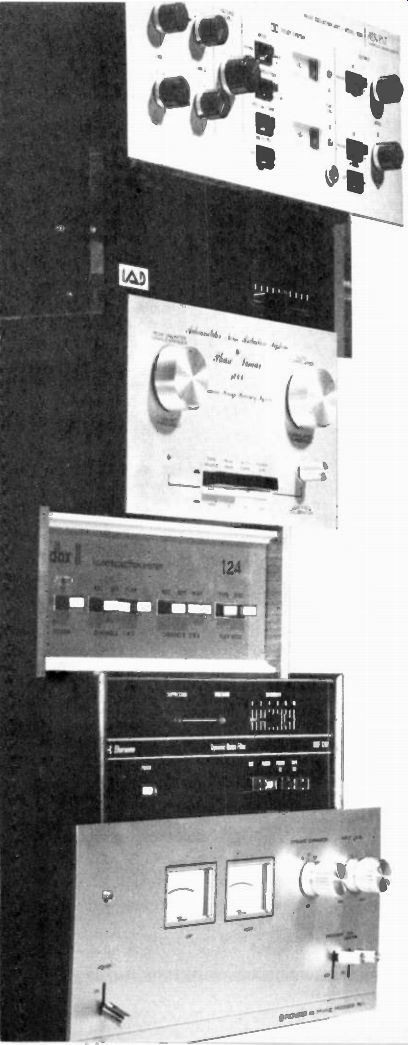
---------- From the top: Advent Model 100A, one of many Dolby B units IAD Model
B3A Dynamic Range Expander Phase Linear Model 1000 Autocorrelator with Peak
Unlimiter and Downward Expander DBX Model 124, one of its encode decode units
Burwen Model DNF-1201 Dynamic Noise Filter Pioneer Model RG-1 Dynamic Processor.
----------
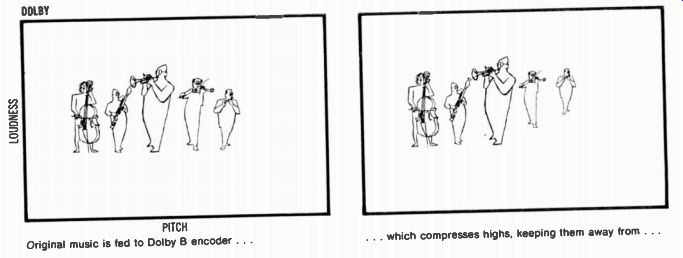
-------- PITCH Original music is fed to Dolby B encoder ... ... which compresses
highs, keeping them away from ...
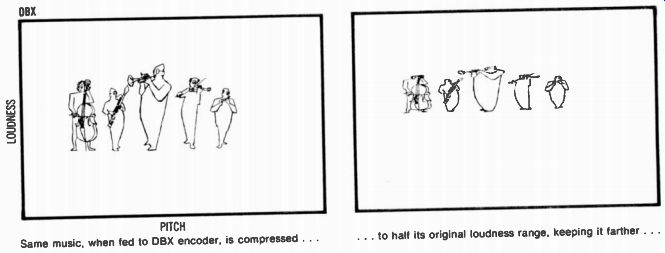
PITCH: Same music, when fed to DBX encoder, is compressed to half its original
loudness range. keeping it farther ...
---------
--------
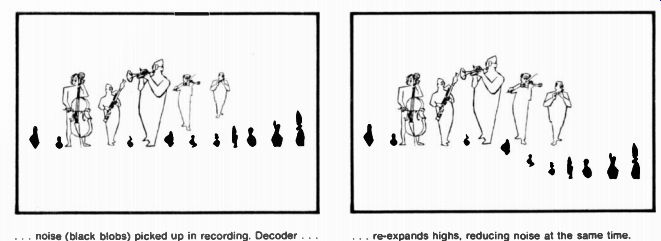
...noise (black blobs) picked up in recording. Decoder .... re-expands highs, reducing noise at the same time.
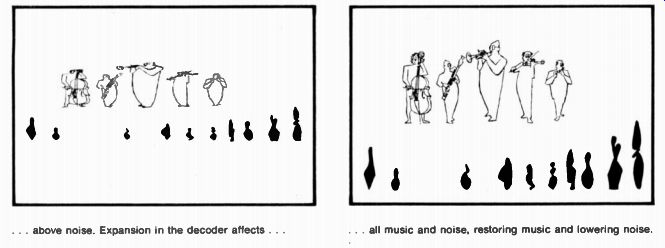
... above noise. Expansion in the decoder affects . . all music and noise,
restoring music and lowering noise.
--------------------
Dynamic Filters
A not-so-modern mutation of simple filtering is what Scott (some twenty-five years ago) called the Dynaural Noise Suppressor. It would begin to roll off the highs (and hence the high-frequency noise) only when program levels fell below a preset threshold at which the music no longer was loud enough to mask the noise. If crudely managed, such devices are given to severe breathing and therefore have never gained widespread popularity. But two modern-and effective-derivatives are available in consumer equipment.
One is Dynamic Noise Limiting, introduced some years ago by Philips specifically to reduce audible noise in cassettes. DNL is a nonadjustable system whose values are carefully chosen to re duce cassette hiss by just enough to achieve an appreciable improvement but not by enough to cause serious unwanted side effects. It was incorporated into cassette decks (see HF test report on the Norelco 2100, February 1973) from several manufacturers and has been available in Europe as a separate add-on unit. It has almost disappeared from the American market, though it is included-along with Dolby B-in the Nakamichi 1000 deck (test reports, August 1973). Unlike DNL, which was conceived as a single purpose device, the Burwen Dynamic Noise Filter is highly flexible. (See the HF test report on the Model 1201, April 1975.) Three basic variables can be controlled in one way or another: sensitivity, bandwidth, and time characteristics.
Sensitivity, of course, refers to the program level below which filtration begins. The bandwidth of the remaining signal obviously is the measure of the frequency range over which the filtration operates-the size of the "bite" it takes out of the highs.
Time characteristics refer to the speed with which the bandwidth closes down in quiet passages and opens up once again when program levels rise.
Generally a very fast "rise" is desirable in any dynamic device of this sort so that sharp transients in the program will not be dulled. An equally fast decay is not equally desirable. Too fast a decay can do peculiar things with such phenomena as the natural decay or reverberance in the music, producing an unnatural effect. And in a dynamic filter such as the Burwen, the greater the degree of filtration, the greater the chance of audible side effects for a given decay time. By increasing the de cay time, the Burwen's "78" setting gives its severe filtration a more gradual closing-down as levels drop than the gentler settings and hence keeps audible side effects under control.
The Encode/Decode Systems
So far, we've been talking about units intended to get rid of-or at least ameliorate-noise that al ready exists in the program source. But an important group of so-called noise-reduction devices might better be called noise preventives. These are all systems that involve some sort of compression, to keep signals up away from noise that may be expected to creep in, and later expansion to return the signal to its original form, pushing the noise that has been picked up while the signal was in its encoded form "out of the way" (by reducing its level) at the same time.
The best known of these devices, surely, is the Dolby B circuit. (The A circuit is used exclusively in professional work.) It encodes (compresses) only the upper end of the frequency range and hence is a preventive only for high-frequency noise like tape and FM hiss. It delivers, subjectively, very close to the nominal 10 dB of improvement.
JVC's Automatic Noise Reduction System is very similar. While some advantages are claimed for ANRS over Dolby B, the two are inter changeable to the extent that program material en coded by one system can be decoded by the other with little, if any, audible "mismatch." The reason that ANRS has not been widely adopted outside JVC's own products appears to be its proprietariness: Why should a competing manufacturer adopt the JVC system when it can use one from Dolby Laboratories, which-since it manufactures no products-is not a competitor? At this writing, JVC has just introduced a new version of ANRS-Super ANRS. It has an additional switch (specifically the Super feature) that adds even more high-frequency compression in recording and expansion in playback. The purpose is not to keep low-level highs even farther above the noise, but to keep high-level highs farther away from tape overload (see the feature article on re cording in the February issue), allowing higher recording levels with music that (like much of rock) is unusually rich in high-frequency content.
The DBX system differs from Dolby B in that it uses much more compression and expansion (2:1- that is, a 60-dB dynamic range is compressed to 30 dB, then re-expanded to 60 dB) and in that it manipulates the entire frequency range-not just the highs. Originally intended for tape recording (Teac now offers it built into tape decks), it also has been applied to disc recordings to deliver a potential dynamic range of something like 100 dB-in other words, a range approaching that of the human ear. The catch for discs is that they must be encoded during recording, and then they can be played satisfactorily only via the DBX decoder.
Still, a few discs cut this way are available.
In taping, too, the DBX system offers considerably greater potential dynamic range than Dolby B. By the same token, it puts a greater premium on the operation of the tape system in one respect. A dropout in the tape or a momentary loss of good tape-to-head contact will, with Dolby B, result in a loss in highs; with DBX it will result in a more severe loss in level across the entire frequency range. Obviously DBX is not recommended for use with cheap tapes and poor transport designs; in good company, however, it can yield excellent results.
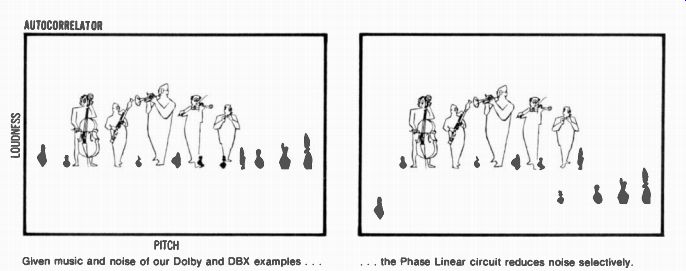
--------------- PITCH : Given music and noise of our Dolby and DBX examples
... the Phase Linear circuit reduces noise selectively.
And, unlike the Dolby system, it does not re quire critical adjustment of levels. Dolby is de signed to begin compression-and expansion-be low a predetermined signal level (Dolby reference level). If the levels are not correctly aligned with Dolby B, the highs can sound over-bright or dull, depending on the "direction" of the misalignment, because of under- or over-expansion and because the remainder of the frequency range is not affected by the processing. Since DBX treats all frequencies at all levels to the same, reciprocal compression and expansion, the actual signal levels at the DBX processor are immaterial as long as they are above its inherent electronic noise and below its inherent electronic overload.
(Incidentally, DBX styles itself dbx. We use capital letters, however, to make clear the proprietary nature of the trade name-just as we do with any proper name.)
The Autocorrelator
This brings us to a unit that is, at present, unique: the Phase Linear Autocorrelator. It is available in two forms--built into the Model 4000 preamp and on its own as the Model 1000. It is the only unit that seeks electronic means of distinguishing between noise and signal in the same frequency bands and at or near the same loudness levels. In theory, the circuit can make the distinction and reduce the level of the noise component while reproducing the signal component unaltered. In practice, its ability to do so is far from absolute, yet audibly greater (to my ear) than that of any other noise-re mover on the market.
The clue to its operation is in its name. Noise characteristically is uncorrelated; that is, it is to tally random. Not all noise-a scratch on a disc, for example, reproduces as a transient in which all frequencies theoretically appear simultaneously and are therefore correlated to that extent. Music and other organized sounds characteristically are correlated in terms of repeating waveforms and harmonic interrelationships.
There are two controls for the Model 1000's Autocorrelator: one for high-frequency noise reduction, the other for removing rumble. That for the highs has by far the greatest audible effect, though the rumble portion is capable of up to 15 dB of noise suppression at 20 Hz, while hiss can be lowered by only 10 dB--albeit in a frequency range to which the ear is particularly sensitive, of course.
The knobs vary the frequency range over which noise is removed. The instructions tell you to turn each until the noise in its frequency band is gone but the music unimpaired. And if the noise is random enough, that's just about the way it works. As you begin turning down the knob for the highs, for example, any hiss becomes progressively more muted. Sooner or later (and assuming that there are highs in your program source), the music too will begin to sound muted.
Since crackle is less random than hiss, it is more difficult to suppress. The sound of cymbals lightly touched with wire brushes, being less coherent than that of, say, violins, is more difficult to pre serve. And in trying to find the optimum setting the ear can easily believe it's losing program highs when it's losing only noise. If this phenomenon leads you to set the control too high in the presence of fairly loud noise, the noise can be gated with the signal to produce an effect approaching the breathing of conventional dynamic filters.
This appears to be, at least in part, a function of a particularly ingenious circuit feature of the Autocorrelator. It is designed to "predict" where the overtone structure of a given, sensed fundamental should fall and to open up the bandpass to let the predicted harmonics through. It is as though the circuitry is examining each little bundle of energy to determine whether it should be suppressed by 10 dB or left as it is and, as you rotate the knob, is becoming progressively more critical in making its decisions. Too high a setting will give the noise the benefit of the doubt; too low a setting will condemn all but the most unequivocal of music components.
The bass control operates similarly but for frequency range. Often it will remove low-level, low frequency "garbage" that you weren't particularly aware of before, but that-once it's gone--you realize had materially compromised the realism of the sound and added to listening fatigue. With some recordings, the improvement is quite astonishing.
Expanding Audio The other main feature of the Phase Linear Model 1000, while unique, generically is one of a rapidly growing group of audio circuits that may be called program expanders. Phase Linear's bears two names, specifying two interrelated functions. The first is the Downward Expander (DE). It reduces the level of very-low-level passages, counteracting the compression that was used in recording (or broadcasting) to keep quiet sounds "out of the mud." Maximum expansion is 3 dB; that is, it can add 3 dB to the bottom of the program's dynamic range.
The Peak Unlimiter (PU) works similarly at the top of the dynamic range and is intended to undo the peak-limiting type of compression that is most commonplace in broadcasting, where it is used to prevent overmodulation of the station's carrier.
Above a threshold point (set by a large knob--symmetrical to the treble Autocorrelator knob on the 1000--which shifts the thresholds of all expander functions simultaneously upward or downward within the dynamic range), the Peak Unlimiter adds upward expansion. A light-emitting diode below the control knob flashes when peaks are going beyond the threshold. Below the threshold,
--------------
IF YOU WANT AN EXPANDER…
As the accompanying article makes plain, I'm not exactly enthusiastic about the potential of program expanders for noise reduction, but they obviously do have a place in a modern stereo system for restoring the dynamic range compromised by compression in the recording and broadcast studios.
The Pioneer is less complex in its operation at any particular setting than the PU / DE circuitry of the Phase Linear, but its operation is variable for different total expansion factors: 6, 8, 10, 12, and 14 dB. I generally end up with the 8- or 10-dB setting, though I avoid the FM stations that compress heavily-the sort of thing for which the higher settings are designed.
Thanks partly to a very efficient control circuit and partly to a release characteristic that is initially fast and then slows down considerably, the action of the unit is extremely difficult to hear. On moderately noisy program material you can hear it, however. At the 8-dB setting it compares very roughly with the Phase Linear in this respect, if you use the Autocorrelator. (With the Autocorrelator switched off the PU DE action is easier to hear because of pumping in the noise.) The IAD is also adjustable-a continuous control varies expansion from zero to some 20 dB (I), with a row of LEDs, displaying the expansion actually at work, in steps of approximately 2 dB. That is, if the third LED from the left lights on peaks, you presumably are getting some 6 dB of expansion. (The IAD presents one minor practical annoyance, incidentally. There is no on/off switch; IAD's instructions are to plug the three-prong AC cord into a switched out let on your preamp. But offhand I can't think of a single component fitted with grounding AC convenience outlets.) The release time on the IAD is unusually slow, a subject of some debate. I tend to favor a slow release time because it minimizes the possibility that the expander will exaggerate dynamic changes within individual musical phrases; some listeners EXPANDER... prefer a faster release because it allows expansion of sudden transients without undue upward shifts in the audible level of accompanying instruments. And when a sudden accent comes along in noisy pro grams, the IAD will shift the noise level sharply up ward behind the transient, then slowly taper the noise off again. This does not sound like true breathing and is less annoying to my ear, but it can be distracting.
The Phase Linear PU /DE circuit does the best job of restoring the "punch" softened by peak limiting in FM broadcasts (the Pioneer is my second choice), but with the Autocorrelator switched off it produces the most audible noise modulation in noisy programs.
But some caveats are in order. Any expander can, at best, undo with precision only one sort of compression: whatever sort is exactly reciprocal to the ex pander. Where the expansion is inexactly related to the compression, audible (if subtle) peculiarities be gin to creep into the sound. And the expanders-particularly the adjustable ones-easily can be over used. Though the extra vividness they lend the music may seem attractive at first listening, the rule is that, if you can hear the expansion as such, you soon will tire of its unnaturalness. A corollary of this statement should be obvious: Music of limited dynamic range (chamber music, for example) that therefore has not been compressed will not benefit from an expander.
(Also, matrixed-quad fans should beware of expanders that control the two channels individually, which makes hash of the encoding. Both the IAD and the Peak Unlimiter appear to control both channels in tandem.) But where the music has audibly been com pressed, as so much of our program material is these days, an expander can help to restore it. And even if the restoration is demonstrably "unnatural" in some minor points, its effect can be more convincing-and more exciting-over-all than program material with no expansion.
R.L.
-------------------
... there's another expander at work, stretching each 10 dB of level variation in the program to about 11 dB, for a maximum of about 3 dB total increase.
This, plus the maximum of 1 1/2 dB added at the top by the PU, plus the 3 dB of the DE, adds up to a 7 1/2 dB maximum increase in the dynamic range available from this portion of the Model 1000. If you add in the 10 dB of high-frequency noise suppression offered by the Autocorrelator, you get a total increase of 17 1/2 dB. At least one manufacturer has made the point that, since program expansion alone increases dynamic range, it is to that extent a form of noise reduction. When noise is severe enough to demand reduction, however, it also is severe enough to fluctuate somewhat with the expansion and draw attention to itself because of what I've called the Change Factor. That is, an expander can make a serious noise problem worse-not better.
But if the noise is down far enough so that you don't hear it except in the quietest passages, use of an expander does indeed increase dynamic range.
And any significant increase in level tends to mask the noise so that-although the expander is raising it on an absolute basis (along with the signal)-you aren't aware of its fluctuations. But to buy an ex pander on the expectation that it will remove noise is, to my way of thinking, a mistake.
So What Works Best?
Let's begin with the preventive systems: DBX, Dolby B, and ANRS. I have heard complaints about them on the ground that they "do" things to the signals processed through them. But I have yet to hear any artificial quality in their processed signals that can be ascribed to the systems. I can't prove that every transient comes out exactly as it went in; but I can hear no difference, and that's enough for me.
In terms of raw available dynamic range, DBX is the clear winner. If a good cassette deck with Dolby or ANRS will deliver something like 60 dB, the same deck with DBX should deliver 80 dB or more, even allowing for the fact that its compression forces the signal's high frequencies tighter against the tape's overload limit and therefore forces you to keep -peaks (as read by the recorder's meters) at lower levels. (DBX recommends maximum meter readings of -3 VU with most open reel decks, -7 VU with most cassette units.) With a good open-reel deck, a dynamic range of 100 dB might not be an unreasonable expectation.
DBX also has a significant advantage in being uncritical of levels for correct operation. But Dolby B has several clear advantages. It already delivers approximately the dynamic range one might need for commonly available signal sources (e.g., the 60 dB cited above, which presupposes the use of chrome or SA tape), to that extent making moot the question of whether any extra dynamic range is desirable. It is less disastrously affected by significant level fluctuations (say, due to poor tape-to-head contact) in related equipment. It al ready has been adopted for prerecorded tapes and FM broadcasting-neither of which is likely to adopt DBX because undecoded DBX is unlistenable, while undecoded Dolby is merely some what shrill.
So it looks as though Dolby B (with ANRS as an alternative) will remain the noise-prevention sys tem of choice for most consumer purposes, with many amateur recordists choosing DBX for its extreme dynamic range, which can pay off in live recording. DBX is widely used by professionals al ready, and for this very reason.
Among the noise-removal devices, I find the Autocorrelator both the most fascinating and the most effective, though no de-noiser (including the Autocorrelator) is a cure-all. It can only improve the apparent noise, and-like competing devices- it will do so only if used judiciously. It is at its best where rumble and hiss are barely audible. In this situation, pressing the Auto-correlator button is like removing a veil from the sound.
As rumble increases, the Autocorrelator continues to do an excellent job in the bass. The treble is more problematical. If the Autocorrelator is set so that it just takes out objectionable hiss with low program levels, higher levels can allow the hiss back in (presumably mistaking it for overtones) with a resultant instability in noise content. The effect is not as obvious as pumping in conventional dynamic devices, but it lends a curious coarseness to the resulting sound. If the Autocorrelator is readjusted for more aggressive noise removal, program highs may appear to suffer- though here we can easily run afoul of the Expectation Factor. But to repeat, even allowing for all that, and even with fairly high noise levels, I find the Autocorrelator over-all the most satisfactory of the noise removers.
Of the general-purpose dynamic filters I've used, the Burwen strikes me as the best. Again, it will attack only so much noise without audible side effects, but it too can effectively remove the veil in already-good signals. So can DNL, but since it is engineered specifically for cassettes its range of capabilities is sharply limited.
To repeat, noise-free program material is preferable to even the best of de-noisers-if only one could find truly noise-free programs. Nonadjustable de-noisers (like DNL) or nondynamic denoisers (like filters) have limited capabilities; the remainder must be used with discretion if their best potential is to be realized. But that potential is considerable, given a reasonably good signal source. They are, so to speak, great for shining up the apple; just don't expect them to remove worms and bruises.
------
(High Fidelity, Mar. 1976)
Also see:
The Best Tape Recordings You'll Ever Make-- by Robert Long and Edward J. Foster. How-to with graphic aids.
Rx for RFI: by William Warriner. How to get rid of those unwanted signals in your stereo system.